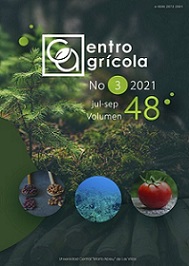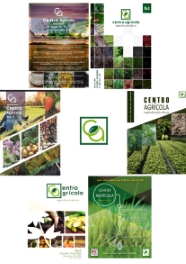RESEARCH ARTICLE
Harvest time in sugar cane and varietal stability in five environmental conditions of Cuba
Los momentos de cosecha en la caña de azúcar y la estabilidad en cinco ambientes de Cuba
Irenaldo Delgado1, Héctor Jorge2, Antonio Vera3, Arian Céspedes4, Isabel Torres5, Rubisel Cruz4, Yoandri Vaillan4, Yaquelín Puchades6, Reynaldo Rodríguez6, Juan C. Pérez7, José C. Santos7, Sergio Guillén7, Héctor García1, Félix R. Díaz1, Harol González1, José Ramón Gómez1, Susana Reyes1, Aylín Gallardo1, Javier Barroso1, Luis F. Machado1 y Dunia Nuñez1
1-Estación Territorial de Investigaciones de la Caña de Azúcar (ETICA) Villa Clara. Autopista Nacional Km. 246, Ranchuelo, Villa Clara, C.P. 53100.
2-Instituto Nacional de Investigaciones de la Caña de Azúcar (INICA). Carretera CAI «Martínez Prieto», km 2½ Rancho Boyeros, La Habana, Cuba, C.P. 19390.
3-Centro Nacional de Hibridación Sancti Spiritus. Carretera a Tres Palmas Km 1.5, Guayos, Sancti Spíritus, Cuba, C.P. 62410.
4-Estación Provincial de Investigaciones de la Caña de Azúcar (EPICA Holguín). Guaro, Mayarí, Holguín, Cuba, C.P. 83000.
5-Estación Territorial de Investigaciones de la Caña de Azúcar Centro-Oriental. Camagüey. Circunvalación Agramonte. Tráfico. Florida. Camagüey, Cuba, C.P. 72810.
6-Estación Territorial de Investigaciones de la Caña de Azúcar Oriente-Sur. Carretera Central Km 2½, Los Coquitos, Palma Soriano, Santiago de Cuba, Cuba, C.P. 92610.
7-Grupo Azucarero AZCUBA. Calle 23 no. 171 entre N y O, Vedado, Plaza de la Revolución, La Habana, Cuba, C.P. 10400.
E-mail: This email address is being protected from spambots. You need JavaScript enabled to view it.
ABSTRACT
Harvesting of sugarcane at a proper time, by adopting right techniques, is necessary to make better use of the available genetic material. By determining the harvesting time period for each sugarcane variety to show its highest potential, both yield and sugar quality, higher levels of profitability are achieved. The aim of this study is to identify the harvest time of sugarcane cultivars, as well as the stability of the cultivars studied in five localities. The study was conducted at the Sugarcane Research Stations in Villa Clara, Sancti Spiritus, Camagüey, Holguin and Santiago de Cuba. Five experiments were planted (one for each locality), in a randomized complete block design with three replications under rainfed agriculture. Two harvest times were established, time 1 (M1), according to the harvest data from November to January (beginning of harvest), and time 2 (M2) taking into account the data collected from February to April (average stage- end of harvest). The discriminant analysis results allowed establishing two harvest times (November to January and February to April) in these five localities, where the effectiveness of each cultivar-Iocality-harvest time combination was higher than 74%. In general, it is advisable the use of cultivars C86-12 and C92-514 during M1 in these five localities, as well as the use of C90-530 in specific zones; and the use of cultivars C92-514 and C89-165 during M2.
.





